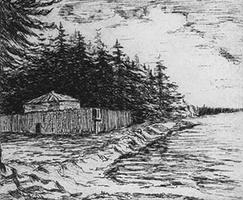This content is from a series created in partnership with Museum Services of the City of Toronto and Heritage Toronto. We gratefully acknowledge funding from the Ontario Ministry of Tourism, Culture and Sport, and the Department of Canadian Heritage.
Toronto Feature: Fort Rouillé
"French Establish Trading Post in Toronto"
In the 17th and 18th centuries, a foot path up the Humber River was the forerunner of today's Highway 400--a key transportation route connecting Lake Ontario with Georgian Bay. It was on that path that Aboriginal traders carried valuable furs to Lake Ontario and to the English post at Oswego. The French built a trading post at the mouth of the Humber River in 1720 to intercept this trade, establishing the first significant European presence in the Mississauga territory that is now Toronto. It was abandoned a decade later. In 1750, they built a second post on the Humber, and in 1751 a fort, this time on the present grounds of Exhibition Place.
Pierre Robinau de Portneuf was designated to carry out the project and he set out from Montréal in late May 1750 and reached Toronto some time later. Portneuf spent two months building the post on the east bank of the Rivière Toronto (Humber River), near its mouth. Trade with the First Nations proved successful, and the governor decided to build a new and larger fort "at the point of the peninsula called La Baye" (about three to four kilometres to the east of the Humber River).
Diplomatically, the governor of New France, Jacques-Pierre de Taffanel de La Jonquière, named the fort "Rouillé" for his boss, Minister of Marine Antoine-Louis Rouillé, and it was finished in April 1751. It was a humble establishment, with small quarters for officers and soldiers, a smithy, a magazine and a kitchen. Only 10-15 soldiers served in its garrison.
Fort Rouillé (or Fort Toronto) proved its worth in helping to build a French alliance with the First Nations. After the outbreak of the Seven Years' War, the Mississauga agreed to participate in the capture of Fort Oswego in 1756. When in 1758-59, British forces gained ascendancy in the Great Lakes, the French garrison at Toronto burned their little outpost and withdrew to Montréal.
The present monument to the fort stands in the west end of Exhibition Place, just to the west of the band shell. Paving stones around it mark where the walls of the old French fort stood, in those days close to the lakeshore.

 Partager sur Facebook
Partager sur Facebook Partager sur X
Partager sur X Partager par Email
Partager par Email Partager sur Google Classroom
Partager sur Google Classroom





